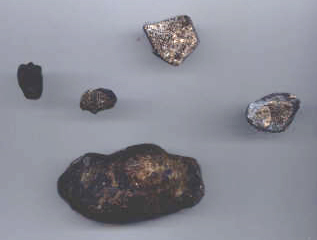Published in the Ocean Watch column, Honolulu Star-Advertiser © Susan Scott
February 10, 2006
Last week I wrote about ambergris, a mass of squid beaks and digestive material about 1 percent of sperm whales heave up at sea. Perfumers value the resulting chunks that wash ashore, because ambergris keeps scent from evaporating.
What does this whale vomit look like? A perfumer, James, wrote me that fresh ambergris is black and tarlike with a bad fishy smell or no smell at all.
But this isn’t the stuff perfumers prize. They prefer ambergris that has floated around the ocean for years. This is light in color and has an agreeable smell. White or gray is the most valuable and James describes its odor, “like a library full of old books.”
He emailed me the picture below of some ambergris he had on hand. One chunk looks like a potato that’s been in the pantry too long. Smaller pieces look like tar balls with gray splotches. The 32-pound piece a couple found recently on an Australian beach looks like a rounded lava rock covered with guano.

One way to identify ambergris is to pierce it with a hot needle. Ambergris melts like chocolate, leaving a tacky coating on the needle.
Still, it’s hard to identify. James writes his company consistently receives what beachcombers believe to be ambergris, but in most cases is some other substance.
In 1933, an East Coast museum naturalist wrote that about half the ambergris brought to him was soap, which dissolves slowly in salt water. People also brought him wax, paint, tallow, mud, rotten fish, wood, residue of picnic lunches, and countless other substances.
Today from 300,000 to a million sperm whales inhabit oceans worldwide, down from about 2 million in the 1940’s. Given this enormous range, and the small number of individuals that produce ambergris, the odds of finding any on a Hawaii beach are tiny. Still, it’s possible.
So if you find some ambergris, what’s the right thing to do?
I don’t know. The concern, of course, is that people will kill sperm whales to get the stuff – and people are killing sperm whales. Currently, Japanese whalers kill at least 10 a year, and a few native Indonesians kill some with hand harpoons. The National Marine Fisheries Service reports evidence of illegal sperm whale hunts in other parts of the world.
No one should be killing sperm whales today, but still, we’ve come along way from the days of whaling. At least the current number of kills is low and conservation awareness is high.
But when the international news media announces that a chunk of ambergris found on a beach will fetch hundreds of thousands of dollars, it hardly matters what the law says or environmentalists think. People will sell it. Our best hope is that perfumers, who can tell the difference, will refuse to buy fresh ambergris from slaughtered whales.
I never thought about ambergris during my beach walks, but I sure will now. If I find any, whatever I decide to do with it, I’ll consider it a remarkable gift from a magnificent animal.